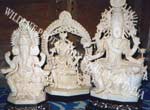Elephant Poaching & Ivory Trade
Investigation
The elephant evokes a strong
emotional reaction in India. Sadly, despite being venerated as a god
and idolised on the big screen as man's best friend, the elephant is
now in desperate straits in the wild due to poaching and loss of
habitat. Only male Asian Elephants bear tusks. The insatiable demand
for ivory has led to the selective slaughter of tuskers in their prime
and as a result the ratio of tuskers and females has fallen to an
alarming low.
WPSI has recorded the loss of over 121 elephants due
to poaching in a period of four years from 2008 to 2011. During this
same period, WPSI has records of 781 kg of ivory, 69 tusks, 31 cut
pieces of ivory, 99 pieces of ivory carvings and 75 ivory bangles that
have been seized from across the country. From 2008 to 2011, a further
50 wild elephants died in road and train accidents and a shocking 111
elephants died from electrocution. But poaching remains the major cause
of death for wild elephants.
 Concerned
by an unusual rise in poaching of tuskers in India, and the probable
impact of the down-listing of the African elephant, WPSI began working
on this issue in the 1990's. We produced two major publications in
collaboration with the Asian Elephant Conservation Centre (AECC), "A
God in Distress" in 1997, and "Signed and Sealed" in 1998. Concerned
by an unusual rise in poaching of tuskers in India, and the probable
impact of the down-listing of the African elephant, WPSI began working
on this issue in the 1990's. We produced two major publications in
collaboration with the Asian Elephant Conservation Centre (AECC), "A
God in Distress" in 1997, and "Signed and Sealed" in 1998.
WPSI
launched its Elephant Conservation Project in June 1999. We established
an informer network in the Corbett-Rajaji region of Uttarakhand to
track down elephant poachers and ivory traders. The network has now
expanded to cover parts of South India, West Bengal, Orissa and Assam.
Information and assistance provided by WPSI’s informers has led to some
significant seizures of ivory. Our Wildlife Crime
Database now has up-to-date information on elephant poaching and the
ivory trade from the states of Kerala, Karnataka, Tamil Nadu, Orissa,
Assam, West Bengal, Chhattisgarh, Uttarakhand and Bihar. Data analysis
has revealed where elephant poaching is rampant, which towns and cities
the illegal ivory trade is prevalent, and the trade routes that are
used to smuggle ivory out of the country. We
regularly hold enforcement and awareness workshops in villages around
protected areas for villagers, forest officials and NGOs. We have also
provided patrolling equipment, wireless sets, etc., to field staff of
some protected areas and territorial divisions, to help them monitor
the forests better and to reduce elephant poaching.
|